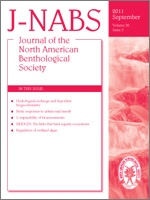Urbanization is an important ecological modifier of stream catchments and significantly alters C type and concentration and heavy metal input to aquatic systems. C and heavy metals are important determinants of microbial community structure (population dynamics) and function (physiological processes). Understanding how changes at the landscape scale affect key nutrient-transformation processes (e.g., denitrification) and C metabolism (e.g., methanogenesis) at the micro scale requires simultaneous determination of the structural and functional responses of bacterial communities. We compared total bacterial (16S ribosomal ribonucleic acid [rRNA] gene) and denitrifying bacterial (nosZ gene) community structures in sediments taken from an urban and a nonurban stream before and after C and Zn additions. Microcosms containing stream sediment were supplemented with either proteinaceous or leaf-leachate C, increasing the C content by ∼36 and 130 mg/L, respectively. C was added in the presence and absence of Zn addition (200 mg/kg). Changes in community function were determined simultaneously with additions by measuring the rates of CO2, N2, and CH4 accumulation in the headspace of each mesocosm. Site had the greatest effect on total and denitrifying bacterial community structures. Added C caused a small but significant change in total bacterial community structure, but did not change denitrifying bacterial community structure. C enrichment caused a significant and rapid change in community function. Rates of methanogenesis were significantly higher at the nonurban than at the urban site and were significantly affected by C type (significant site × C interaction). Denitrification and CO2 production were unaffected by C additions but differed between sites. Zn addition changed total bacterial community structure but not denitrifying bacterial community structure. Zn affected the rate of methanogenesis, but the effect size was less than for C type. Community structures remained different between sites at the end of the study despite exposure to Zn concentrations that reflected conditions in urbanized streams and C sources that mimicked those from urban or nonurban streams. Our study supports previous observations that microbial community structure is strongly influenced by prior sediment history. The broader implication is that landscape-scale changes like urbanization alter other physical and chemical properties of the stream sediment that influence community structure more than the Zn or C concentrations in our study.
How to translate text using browser tools
6 September 2011
Sediment bacterial community structure and function in response to C and Zn amendments: urban and nonurban streams
Shane E. Perryman
ACCESS THE FULL ARTICLE
It is not available for individual sale.
This article is only available to subscribers.
It is not available for individual sale.
It is not available for individual sale.





